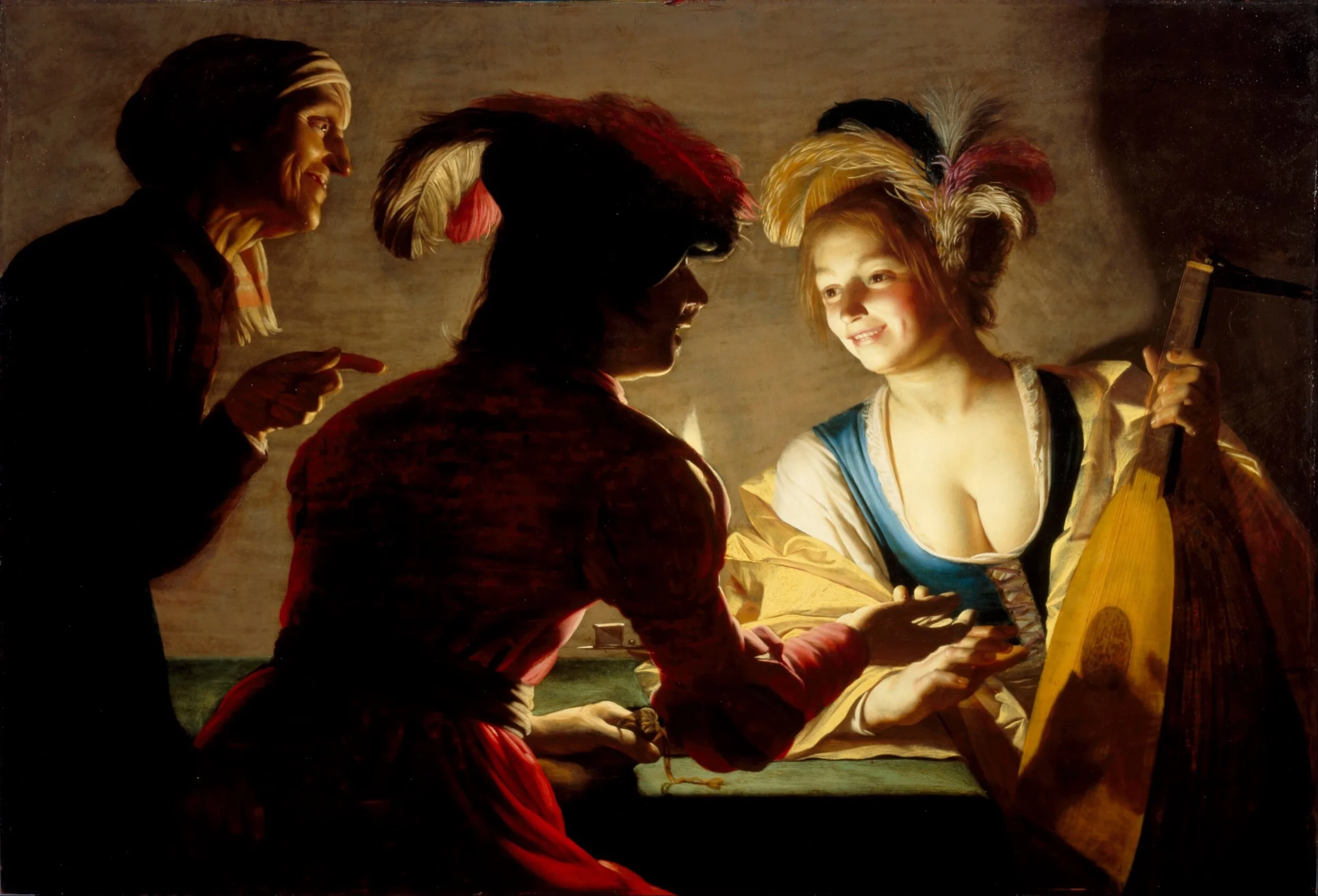The procuress, Gerard van Honthorst, 1625. w104 x h71 cm, oil painting, Central Museum
“An old secret fire burns between us, giving sparse light and ample warmth. The primordial fire that conquers every necessity shall burn again, since the night of the world is wide and cold, and the need is great.”
The Dutch painter Gerard Van Honthorst, very well known for his lit scenes, symbolizes with this painting the creative fire and erotic life extensively analyzed by Carl Jung’s psychoanalytic theories, and embodied in this artwork by the beauty of the prostitute and her relationship with the other two subjects. First of all, it is important to account for the importance behind the uses of dark scenes and plays of shadows from a psychoanalytic perspective, a formula that made Honthorst very famous and was explored by Jung’s studies. Based on Jungian psychoanalysis, darkness is the very place to kindle the light of meaning, it is the unconscious part of our psyche where dreams and myth are created. By the very act of painting, besides the portrayal of very confined, dark environments, the artist evokes the darkness of consciousness.
The focal point of this painting resides primarily on the young prostitute who gracefully shines lighted by the candle fire. Even though the silhouette and back of the young man take on special prominence at the foreground of the painting, his body has been placed on the side of the shadow leaving only a few clear details to the sight of the viewer. The Shadow archetype is one of Jung’s most mentioned themes, referring to the unknown aspects of our minds and the more primitive part of ourselves. Also, the shadow is what separates the ego from the real world, which could be related to the fact that the men and the young prostitute do not join their hands but in the meeting of their shadows. Here it is accurate to focus on the feathered hat and the lute, both highly sexual symbols, the latter object possessing a double masculine and feminine character. This instrument has been used as a phallic symbol as much as to symbolize the female body. The Flemish for lute – luit – also meant vagina, and in Dutch art the instrument is often carried by prostitutes*. So we could infer by this shadow projection on the lute that the craving and desire for union, physical and psychological, still lurks in the unconscious. This trinity of subjects unified at its core by the light of the candle possesses a divine nature. Even the prostitutes are very often depicted in celestial blue garments alluding to the Holy Mary. The personifications of this trinity varies depending on its psychological origin: the father, the son, and the holy ghost are the most known to us based on Christian mythology, and for the case of this triad, the old woman, the begotten son, and the prostitute. The interpretation of this work is vast and complex due to the individual character of the subjects and objects displayed in relationship with each other.
As an example, the archetype of the old woman, also known as Hecate in the world of Greek mythology, has been defined in great depth (entire books have been dedicated to this archetype) by contemporary Jungian analysts such as Dr. Clarissa Pinkola Estes, who has described this particular character as ‘the one who stands in between the worlds of rationality and mythos’, ‘The One Who Knows’, and for the case of this artwork between the world of men and the one of divine beauty, pleasure, and creation. The old woman embodies the ageless land of mysteries and creation; she is the one who gives the fire to the initiated, the bridge between the mundane and the sacred, where poetry, dance, stories, and music are some of the instruments that allows us to experience it. Many other psychological symbols of transformation, such as the creative fire, also analyzed by Jungian theories, reveals the complexity of this work and its significance which goes beyond the depiction of a scene.
-Estés, Clarissa Pinkola. Women Who Run with the Wolves : Myths and Stories of the Wild Woman Archetype. New York :Ballantine Books, 1992.
-Jung, C. G. The Archetypes and the Collective Unconscious. Princeton, N.J. :Princeton University Press, 1980.
-Jung, C. G. 1875-1961. 1973. Memories, Dreams, Reflections. New York: Pantheon Books.
-Signs and symbols. Fitz Museum. https://www.fitzmuseum.cam.ac.uk/pharos/collection_pages/northern_pages/76/TXT_BR_SS-76.html
